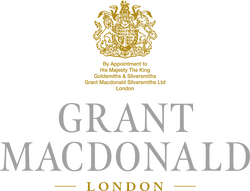One of the things that makes a personalised piece of silver, that little bit special, is engraving. Specifically, hand engraving, which is not to be confused with etching, engine turning or chasing which is a way of hand finishing textures like feathers, fur or other organic finishes. Engraving is something quite different and special in it’s own right.

Engraving is the art of using a hard edge to cut away material to create relief. Guilloché engine turning and machine engraving do this with a machine so that metal can be textured precisely. Chasing is hammering with a blunt edge to make fine dents and depressions in the surface of the metal - and a fine art indeed.
Hand engraving, however, is the most unforgiving of these skills. Whereas with guilloche you have the precision of a machine, and with chasing you can re-chase to eliminate imperfections and make improvements, hand engraving is either perfect or you have to begin again. It is for this reason that our engraving is only undertaken by master craftsmen who have the skills and experience to do it perfectly, first time, every time.
Typically, hand engraving has many similarities with calligraphy. We usually hand engrave the initials, name or crest of our bespoke clients into their commissions as requested. This tradition dates back to the times when people wrote with sharp cut quills or early fountain pen nibs, that has the same kind of chisel-like edges as a burin (the hand engravers tool). This lends itself to the blend of thin and broad strokes that you’ll see in the romantic letterforms of calligraphy, with the swirls and serifs that can be found dating back to medieval times.

Engraving has its roots in the world of print and mark-making, like etching, and hence it’s synergy with making letters and words shine out in metal and wood. It gives relief to the letters, using angles and v-shaped grooves to create an impression of depth that is greater than the volume of material that is removed. The result preserves the maximum amount of precious metal and means the engraved pieces can be lighter and shaped into more elaborate designs like trophies, claret jugs, goblets and paper knives.
There’s no eraser, tippex or delete button for the engraver. You need a steady hand, and even steadier nerves to become a master at it.
